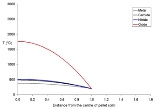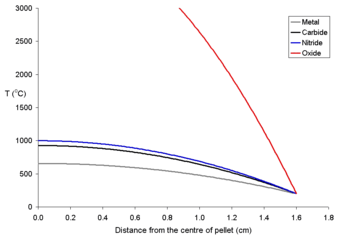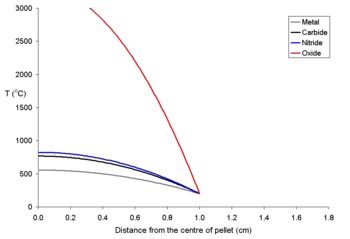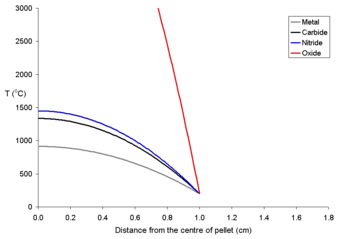
Post Irradiation Examination
Encyclopedia
Post Irradiation
Examination (PIE) is the study of used nuclear materials such as nuclear fuel
. It has several purposes. It is known that by examination of used fuel that the failure modes which occur during normal use (and the manner in which the fuel will behave during an accident) can be studied. In addition information is gained which enables the users of fuel to assure themselves of its quality and it also assists in the development of new fuels. After major accidents the core (or what is left of it) is normally subject to PIE in order to find out what happened. One site where PIE is done is the ITU
which is the EU centre for the study of highly radioactive materials.
Materials in a high radiation environment (such as a reactor) can undergo unique behaviors such as swelling and non-thermal creep. If there are nuclear reactions within the material (such as what happens in the fuel), the stoichiometry will also change slowly over time. These behaviors can lead to new material properties, cracking, and fission gas release:
may become free.
In order to better understand and control these changes in materials, these behaviors are studied.http://www.scn.ro/lepi.htmhttp://www.ornl.gov/~webworks/cppr/y2001/pres/114819.pdf http://www.rertr.anl.gov/Web2002/2003%20Web/Rugirello.html http://www.nea.fr/html/trw/docs/mol98/session3/SIIIpaper2.pdf. Due to the intensely radioactive nature of the used fuel this is done in a hot cell
. A combination of nondestructive and destructive methods of PIE are common.
In addition to the effects of radiation and the fission products on materials, scientists also need to consider the temperature of materials in a reactor, and in particular, the fuel. Too high of fuel temperatures can compromise the fuel, and therefore it is important to control the temperature in order to control the fission chain reaction.
The temperature of the fuel varies as a function of the distance from the centre to the rim. At distance x from the centre the temperature (Tx) is described by the equation
where ρ is the power density (W m-3) and Kf is the thermal conductivity
.
To explain this for a series of fuel pellets being used with a rim temperature of 200 oC (typical for a BWR) with different diameters and power densities of 250 Wm-3 have been modeled using the above equation. Note that these fuel pellets are rather large; it is normal to use oxide pellets which are about 10 mm in diameter.
Irradiation
Irradiation is the process by which an object is exposed to radiation. The exposure can originate from various sources, including natural sources. Most frequently the term refers to ionizing radiation, and to a level of radiation that will serve a specific purpose, rather than radiation exposure to...
Examination (PIE) is the study of used nuclear materials such as nuclear fuel
Nuclear fuel
Nuclear fuel is a material that can be 'consumed' by fission or fusion to derive nuclear energy. Nuclear fuels are the most dense sources of energy available...
. It has several purposes. It is known that by examination of used fuel that the failure modes which occur during normal use (and the manner in which the fuel will behave during an accident) can be studied. In addition information is gained which enables the users of fuel to assure themselves of its quality and it also assists in the development of new fuels. After major accidents the core (or what is left of it) is normally subject to PIE in order to find out what happened. One site where PIE is done is the ITU
Institute for Transuranium Elements
The Institute for Transuranium Elements is a European Commission nuclear research institute in Karlsruhe, Germany. The ITU is one of the seven institutes of the Joint Research Centre , a Directorate-General of the European Commission . The ITU has about 300 staff...
which is the EU centre for the study of highly radioactive materials.
Materials in a high radiation environment (such as a reactor) can undergo unique behaviors such as swelling and non-thermal creep. If there are nuclear reactions within the material (such as what happens in the fuel), the stoichiometry will also change slowly over time. These behaviors can lead to new material properties, cracking, and fission gas release:
Fission gas release
As the fuel is degraded or heated the more volatile fission products which are trapped within the uranium dioxideUranium dioxide
Uranium dioxide or uranium oxide , also known as urania or uranous oxide, is an oxide of uranium, and is a black, radioactive, crystalline powder that naturally occurs in the mineral uraninite. It is used in nuclear fuel rods in nuclear reactors. A mixture of uranium and plutonium dioxides is used...
may become free.
Fuel cracking
As the fuel expands on heating, the core of the pellet expands more than the rim which may lead to cracking. Because of the thermal stress thus formed the fuel cracks, the cracks tend to go from the centre to the edge in a star shaped pattern.In order to better understand and control these changes in materials, these behaviors are studied.http://www.scn.ro/lepi.htmhttp://www.ornl.gov/~webworks/cppr/y2001/pres/114819.pdf http://www.rertr.anl.gov/Web2002/2003%20Web/Rugirello.html http://www.nea.fr/html/trw/docs/mol98/session3/SIIIpaper2.pdf. Due to the intensely radioactive nature of the used fuel this is done in a hot cell
Hot cell
Shielded nuclear radiation containment chambers are commonly referred to as hot cells. The word "hot" refers to radioactivity.Hot cells are used in both the nuclear-energy and the nuclear-medicines industries....
. A combination of nondestructive and destructive methods of PIE are common.
In addition to the effects of radiation and the fission products on materials, scientists also need to consider the temperature of materials in a reactor, and in particular, the fuel. Too high of fuel temperatures can compromise the fuel, and therefore it is important to control the temperature in order to control the fission chain reaction.
The temperature of the fuel varies as a function of the distance from the centre to the rim. At distance x from the centre the temperature (Tx) is described by the equation
Equation
An equation is a mathematical statement that asserts the equality of two expressions. In modern notation, this is written by placing the expressions on either side of an equals sign , for examplex + 3 = 5\,asserts that x+3 is equal to 5...
where ρ is the power density (W m-3) and Kf is the thermal conductivity
Thermal conductivity
In physics, thermal conductivity, k, is the property of a material's ability to conduct heat. It appears primarily in Fourier's Law for heat conduction....
.
- Tx = TRim + ρ (rpellet2 - x2) (4 Kf)-1
To explain this for a series of fuel pellets being used with a rim temperature of 200 oC (typical for a BWR) with different diameters and power densities of 250 Wm-3 have been modeled using the above equation. Note that these fuel pellets are rather large; it is normal to use oxide pellets which are about 10 mm in diameter.
 |
 |
 |
 |
 |

